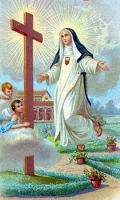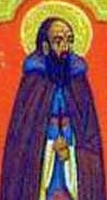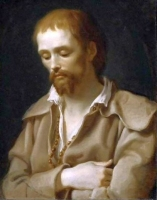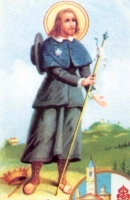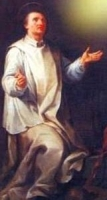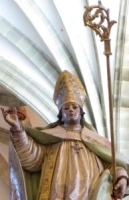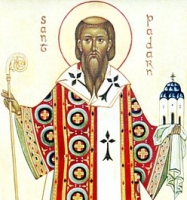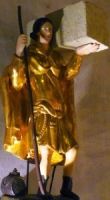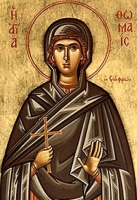St. Anicetus
புனிதர் அனிசேட்டஸ்
11ம் திருத்தந்தை:
இயற்பெயர்: அனிசேட்டஸ்
பிறப்பு: உறுதியாகத் தெரியவில்லை
இறப்பு: கிபி சுமார் ஏப்ரல் 20, 167
ரோம், ரோமப் பேரரசு
நினைவுத் திருநாள்: ஏப்ரல் 17
திருத்தந்தை புனிதர் அனிசேட்டஸ் (Pope Saint Anicetus), ரோம் நகர ஆயராகவும், கத்தோலிக்க திருச்சபையின் திருத்தந்தையாகவும், கி.பி. சுமார் 150ம் ஆண்டிலிருந்து 167ம் ஆண்டு வரை பணிபுரிந்தார். இவர் கத்தோலிக்க திருச்சபையின் 11ம் திருத்தந்தை ஆவார். லூயி டுக்கேன் (Louis Duchesne) என்னும் வரலாற்றாசிரியர் கருத்துப்படி, முதல் இரண்டு நூற்றாண்டுகளில் நிகழ்ந்த திருச்சபை வரலாற்றுச் செய்திகளைத் துல்லியமாகக் கால வரையறை செய்வது மிகக் கடினம்.
அனிசேட்டஸ் பண்டைய சிரியா நாட்டில் ஏமெசா (Emesa) என்னும் நகரில் பிறந்தார். ஏமெசா இன்று ஹோம்ஸ் (Homs) என்று அழைக்கப்படுகிறது. மரபுப்படி, அனிசேட்டசின் தந்தை, இன்றைய சுவிட்சர்லாந்து பகுதியிலிருந்து சிரியா நாட்டுக்குப் பெயர்ந்துசென்றவர் ஆவார்.
ஞானக்கொள்கைக்கு எதிர்ப்பு:
அனிசேட்டஸ் உரோமைக்கு ஏன் வந்தார் என்பது பற்றித் தெளிவில்லை. ஒருவேளை அவர் ஞானக்கொள்கை (Marcionism and Gnosticism) என்னும் தப்பறையை எதிர்த்ததால் கீழைத் திருச்சபையை விட்டு உரோமைக்குச் செல்லும் கட்டாயம் எழுந்திருக்கலாம்.
அந்நாட்களில் உரோமையில் மார்சியோன் (Marcion of Sinope) என்பவர் ஞானக்கொள்கையைப் (Marcionism) பரப்பிவந்தார். அதை அனிசேட்டஸ் எதிர்த்தார். உரோமையில் புனித ஜஸ்டின் நிறுவியிருந்த கல்விக்கூடம் இந்த எதிர்ப்பில் அவருக்குத் துணையாக இருந்தது. திருத்தூதர்களிடமிருந்து பெறப்பட்ட கத்தோலிக்க கிறித்தவ கொள்கையின் பெயரால் அவர் ஞானக்கொள்கை போன்ற தவறான மெய்யியல் அணுகுமுறைகளை எதிர்த்துப் போராடினார்.
குருக்கள் நீண்ட முடி வளர்க்க தடை:
"திருத்தந்தையர் நூல்" (Liber Pontificalis) என்னும் ஏட்டின்படி, கத்தோலிக்க குருக்கள் நீண்ட முடி வளர்த்தலாகாது என்று அனிசேட்டஸ் தடைவிதித்தார். இது ஒருவேளை ஞானக்கொள்கையினர் நீண்ட முடி வளர்த்ததால் அவர்களிடமிருந்து கிறித்தவப் பணியாளர்களை வேறுபடுத்தும் நோக்கத்துடன் நிகழ்ந்திருக்கலாம்.
புனித பொலிக்கார்ப்போடு (Polycarp of Smyrna) சந்திப்பு:
ஸ்மிர்னா (Smirna) நகரத்தின் ஆயரும் 80 வயது நிரம்பியவருமான புனித பொலிக்கார்ப்பு ஆசிய சபைகளின் தூதுவராக உரோமைக்கு அனுப்பப்பட்டு, அங்கே திருத்தந்தை அனிசேட்டசை சந்தித்துப் பேசினார். புனித பொலிக்கார்ப்பு நற்செய்தியாளராகிய புனித யோவானின் சீடராக இருந்தார் என்பது மரபு. ஒருவேளை அவர் குரு யோவான் (John the Presbyter) என்பவரின் சீடராக இருந்திருக்கலாம் என்று சில அறிஞர் கருதுகின்றனர்.
பொலிக்கார்ப்பின் சீடராக இருந்த புனித லியோன் நகர இஞ்ஞாசியார் இத்தகவலைத் தருகிறார்.
இயேசுவின் உயிர்த்தெழுதல் கொண்டாடப்பட வேண்டிய நாள்:
பொலிக்கார்ப்பு கீழைத் திருச்சபையிலிருந்து திருத்தந்தை அனிசேட்டசைத் தேடி உரோமைக்கு வந்தது இயேசுவின் உயிர்த்தெழுதலை எந்த நாளில் கொண்டாடுவது என்பது பற்றித் தெளிவுபெறுவதற்கு ஆகும். பொலிக்கார்ப்பும் அவர் தலைமை வகித்த ஆசிய நாட்டு ஸ்மிர்னா பகுதியும் இயேசுவின் உயிர்த்தெழுதலை நிசான் மாதத்தின் 14ஆம் நாள் கொண்டாடினர். அந்நாளில்தான் யூதர்கள் பாஸ்கா விழாவைக் கொண்டாடுவது வழக்கம். ஆனால் நிசான் மாதத்தின் 14ஆம் நாள் வாரத்தின் ஏதாவது ஒரு நாளாக இருக்கலாம். அது ஞாயிற்றுக் கிழமையாக எல்லா ஆண்டுகளிலும் இராது. எனவே இந்நிலைப்பாடு "பதினான்காம் நாள் கொள்கை" என்னும் பெயர் பெற்றது.
இவ்வாறு கொண்டாடும் பழக்கம் திருத்தூதர் காலத்திலிருந்தே பெறப்பட்டது என்றும், குறிப்பாக, யோவான் (திருத்துதர் அல்லது குரு) சமூகத்தில் அவ்வழக்கம் நிலவியது என்றும் கீழைச் சபை வாதாடியது.
ஆனால் உரோமைத் திருச்சபை இயேசுவின் உயிர்த்தெழுதல் விழாவை ஆண்டுதோறும் ஞாயிற்றுக் கிழமைதான் கொண்டாடியது. ஏனென்றால் ஞாயிற்றுக் கிழமை இயேசு உயிர்த்தெழுந்ததால் அது "ஆண்டவரின் நாள்" (Day of the Lord) என்று அழைக்கப்பட்டதோடு கிறித்தவர்களின் பாஸ்கா விழாவாகவும் மாறியிருந்தது. நிசான் மாதத்தின் 14ஆம் நாள் ஞாயிற்றுக் கிழமையாக இருந்தால் அன்று உயிர்த்தெழுதல் விழாக் கொண்டாடப்படும். அவ்வாறு இல்லாவிடின், நிசான் 14ஆம் நாளுக்குப் பின் வருகிற முதல் ஞாயிறு உயிர்த்தெழுதல் ஞாயிறு ஆகும்.
ஆண்டுதோறும் இயேசுவின் உயிர்த்தெழுதல் விழாவை நிசான் மாதம் 14ஆம் நாள் கொண்டாடுவதா, அல்லது நிசான் 14ஆம் நாளை அடுத்துவரும் ஞாயிறன்று அவ்விழாவைக் கொண்டாடுவதா என்பது பற்றி அனிசேட்டசுக்கும் பொலிக்கார்ப்புக்கும் இடையே ஒத்த கருத்து உருவாகவில்லை. இருந்தாலும் திருத்தந்தை அனிசேட்டஸ் உரோமைத் திருச்சபையின் வழக்கத்தைக் கீழைச் சபையின்மீது திணிக்க விரும்பவில்லை. எனவே இரு சபைகளும் தம் மரபுக்கு ஏற்ப உயிர்த்தெழுதல் விழாவைக் கொண்டாடி வரலாயின.
பிற்காலத்தில் உயிர்த்தெழுதல் விழாவை எந்த நாளில் கொண்டாடுவது என்பது பற்றிய விவாதம் மீண்டும் எழுந்தது.
வரலாற்றாசிரியர் ஹெகேசிப்பஸ் (Hegesippus) உரோமை வருகை:
பண்டைய கிறித்தவ வரலாற்றாசிரியர் ஹெகேசிப்பஸ் (Hegesippus) என்பவரும் திருத்தந்தை அனிசேட்டசைச் சந்திக்க உரோமை சென்றார். உரோமைப் பீடம் தொடக்க காலத்திலிருந்தே முதன்மை பெற்றதற்கு இதுவும் ஒரு அடையாளமாகக் கொள்ளப்படுகிறது.
மொந்தானியக் கொள்கை (Montanism) கண்டிக்கப்படுதல்:
திருத்தந்தை அனிசேட்டஸ் மொந்தானியக் கொள்கையைக் கண்டனம் செய்தார். கீழைத் திருச்சபையில் மொந்தானுஸ் (Montanus) என்பவர் கிபி இரண்டாம் நூற்றாண்டின் நடுப்பகுதியில் "புதிய இறைவாக்கு இயக்கம்" (New Prophecy) என்றொரு போக்கினைத் தோற்றுவித்தார். தாம் தூய ஆவியால் தூண்டப்பட்டு இறைவாக்கு உரைத்ததாகவும், கடுமையான அறநெறி நடத்தையே கடவுளுக்கு உகந்தது என்றும் அவர் போதித்தார். கிறித்தவக் கொள்கைக்கு எதிராக அவர் போதித்தார் என்று அனிசேட்டஸ் மொந்தானியக் கொள்கையை (Montanism) கண்டனம் செய்தார்.
இறப்பு:
திருத்தந்தை அனிசேட்டஸ் ரோமப் பேரரசன் லூசியஸ் வேர்சஸ் (Lucius Verus) என்பவரின் ஆட்சியில் கிறித்தவ நம்பிக்கையின் பொருட்டுக் கொல்லப்பட்டார் என்பது மரபு. ஆனால் இதற்கு வரலாற்று ஆதாரம் இல்லை. ஏப்ரல் மாதம் 16, 17, 20 ஆகிய நாள்கள் அவரது இறப்பு நாளாகக் குறிக்கப்படுகின்றன. இருப்பினும், ஏப்ரல் 20ம் நாள் அவர் இறந்ததாகக் கொண்டு அன்று அவருடைய திருவிழா கொண்டாடப்படுகிறது. பழைய வழக்கப்படி, ஏப்ரல் 17ம் நாள் அவர் திருநாள் கொண்டாடப்பட்டது.
Church Early Christianity
Papacy began c. 157
Papacy ended c. 20 April 168
Predecessor Pius I
Successor Soter
Personal details
Born late 1st century
Emesa, Phoenice
Died April 168
Rome, Roman Empire
Sainthood
Feast day 20 April (West)
17 April (East)
Attributes Papal tiara, palm branch
Anicetus was a Syrian from Emesa. He became pope about 155 and actively opposed Marcionism and Gnosticism. His pontificate saw the appearance of the controversy between East and West over the date of Easter. St. Polycarp, a disciple of John, is reported to have visited him in Rome about the dispute, which was to accelerate and grow more heated over the following centuries.
Not to be confused with Pope Anacletus.
Pope Anicetus was the bishop of Rome from c. 157 to his death in April 168.[3] According to the Annuario Pontificio, the start of his papacy may have been 153. Anicetus actively opposed Gnosticism and Marcionism. He welcomed Polycarp of Smyrna to Rome to discuss the Easter controversy.
According to the Liber Pontificalis, Anicetus was a Syrian from the city of Emesa (modern-day Homs).
According to Irenaeus, it was during his pontificate that the aged Polycarp of Smyrna, a disciple of John the Evangelist, visited Rome to discuss the celebration of Easter with Anicetus. Polycarp and his Church of Smyrna celebrated the crucifixion on the fourteenth day of Nisan, which coincides with Pesach (or Passover) regardless of which day of the week upon this date fell, while the Roman Church celebrated Easter on Sunday—the weekday of Jesus's resurrection. The two did not agree on a common date, but Anicetus conceded to Polycarp and the Church of Smyrna the ability to retain the date to which they were accustomed. The controversy was to grow heated in the following centuries.[5]
The Christian historian Hegesippus also visited Rome during Anicetus's pontificate. This visit is often cited as a sign of the early importance of the Roman See.[5]
Anicetus actively opposed the Gnostics and Marcionism.[citation needed] The Liber Pontificalis records that Anicetus decreed that priests are not allowed to have long hair (perhaps because the Gnostics wore long hair).[4]
According to church tradition, Anicetus suffered martyrdom during the reign of Emperor Lucius Verus, but there are no historical grounds for this account.[6] 16, 17 and 20 April are all cited as the date of his death, but 20 April is currently celebrated as his feast day.[1] Before 1970, the date chosen was 17 April.[6] The Liber Pontificalis states he was buried in the cemetery of Callistus.
Saint Kateri Tekakwitha
கத்தேரி தேக்கக்விதா
(1656 – ஏப்ரல் 17, 1680), (திருமுழுக்கு பெயர்: கேத்ரின் தேக்கக்விதா[2][3]) என்றும் மோகாக்கியரின் லில்லி மலர் என்றும் அறியப்படுபவர் ஒரு அல்கோன்குயின்-மோகாக்கிய கத்தோலிக்க கன்னியரும், பொது நிலைத்துறவியும் ஆவார். இவர் தற்போது நியூ யோர்க் மாநிலம் அமைந்துள்ள இடத்தில் பிறந்தவர். இவர் சிறுவயதில் பெரியம்மையால் தாக்கப்பட்டு பிழைத்தவர் ஆவார். இவர் இளமையிலேயே பெற்றோரை இழந்தவர். இவர் தனது 19ஆம் அகவையில் கத்தோலிக்கத்துக்கு மதம் மாறித் திருமுழுக்கு பெற்றார். இதன்பின் இவர் தனது வாழ்நாளை இயேசு சபை மறைபணி தளமான மொண்ட்ரியாலில் உள்ள கானாவாக்கே கிராமத்தில் கழித்தார்.
இவர் தனது 24ஆம் அகவையில் கற்பு நிலை உறுதிபூண்டார். தனது நல்லொழுக்கத்திற்கும் கற்பு நிலைக்கும் பேர்போன இவர் தனது கடும் தவ முயற்சிக்காக அறியப்படுகின்றார். இவர் கத்தோலிக்கத்துக்கு மதம் மாறியதால் தனது சொந்த குடும்பத்தாலும், இனத்தாலும் ஒதுக்கப்பட்டார்.
அமெரிக்க முதற்குடிமக்களுள் திருச்சபையின் பீட மகிமை அளிக்கப்பட்ட முதல் பெண் இவர் ஆவார். இவருக்குத் திருத்தந்தை இரண்டாம் அருள் சின்னப்பர் 1980இல் அருளாளர் பட்டம் அளித்தார். திருத்தந்தை பதினாறாம் பெனடிக்ட், அக்டோபர் 21, 2012இல் புனித பேதுரு பேராலயத்தில் இவருக்குப் புனிதர் பட்டம் அளித்தார். பல்வேறு அதிசயங்களும் இயற்கைக்கு மீறிய நிகழ்வுகளும் இவரது மரணத்திற்கு பின்னர் நிகழ்ந்துள்ளதாகக் கூறப்படுகின்றது.
பிறப்பு 1656
ஓசர்நினோன், இரோக்குவா பிரதேசம் - 1793 வரை "புது பிரான்சு" (தற்போது ஓரிஸ்வில், நியூ யோர்க் மாநிலம்)
இறப்பு ஏப்ரல் 17, 1680
கானாவாக்கே, மொண்ட்ரியால், கியூபெக், கனடா
ஏற்கும் சபை/சமயங்கள் கத்தோலிக்க திருச்சபை
அருளாளர் பட்டம் ஜூன் 22, 1980, வத்திக்கான் நகர் by இரண்டாம் யோவான் பவுல்
புனிதர் பட்டம் அக்டோபர் 21, 2012, வத்திக்கான் நகர் by திருத்தந்தை பதினாறாம் பெனடிக்ட்
முக்கிய திருத்தலங்கள் புனித பிரான்சிஸ் சவேரியார் ஆலயம், கியூபெக், கனடா
திருவிழா ஜூலை 14 (அமெரிக்க ஐக்கிய நாடு), ஏப்ரல் 17 (கனடா)
சித்தரிக்கப்படும் வகை லில்லி மலர்; கடல் ஆமை; செபமாலை
பாதுகாவல் சூழலியலாளர், சுற்றுச்சூழல், சூழலியம், அனாதைகள், நாடுகடத்தப்பட்டவர், தங்களது பக்திக்காக கேலிக்கு உள்ளாகுபவர், அமெரிக்க முதற்குடிமக்கள்
கத்தேரியின் இறப்பு
1679ஆம் ஆண்டு, இயேசு துன்பங்கள் அனுபவித்து, இறந்து உயிர்பெற்றெழுந்த நிகழ்ச்சியை நினைவுகூரும் வாரத்தின்போது கத்தேரியின் உடல் நிலை மிகவும் மோசமானதை அவருடைய நண்பர்கள் கண்டனர். இன்னும் ஒருசில மணி நேரம் மட்டுமே அவருடைய உயிர் நீடிக்கும் என்று உணர்ந்த கிராம மக்கள் அனைவரும் கத்தேரியைச் சூழ்ந்து கூடினர். அவர்களோடு இயேசு சபைத் துறவியர் ஷோஷத்தியே மற்றும் கோலனெக் ஆகிய இருவரும் வந்தனர்.
தந்தை கோலனெக் கத்தேரிக்கு இறுதிச் சடங்காகிய நோயில் பூசுதல் என்னும் திருவருட்சாதனத்தை வழங்கினார்.[4]
அமெரிக்க முதற்குடி கிறித்தவரான கத்தேரி தெக்கக்விதா என்னும் புனிதப் பெண்மணி தம் 24ஆம் வயதில், 1680, ஏப்பிரல் 17ஆம் நாளன்று, உயிர்துறந்தார். அப்போது அவர் அருகே மரி-தெரேசும் உண்டு. கத்தேரியை நேரடியாகத் தெரிந்து, அவருடைய வாழ்க்கை வரலாற்றை எழுதிய தந்தை ஷோஷத்தியே கூறுவது போல, கத்தேரி தாம் இறப்பதற்கு முன் உரைத்த கடைசி சொற்கள் இவை: "இயேசுவே, நான் உம்மை அன்புசெய்கிறேன்." [4]
கத்தேரியின் உடல் ஒளிவீசுதல்
கத்தேரியின் உயிர் உடலை விட்டுப் பிரிந்ததும் அவ்வுடலில் ஒரு மாற்றம் நிகழ்ந்ததைச் சூழ்ந்து நின்றோர் கண்டனர். தந்தை கோலனெக் கூறுகிறார்: "தழும்புகளால் தடித்துப்போன கத்தேரியின் அந்த முகம், அவருடைய இறப்புக்குப் பின் ஒரு மணி நேரத்தில் எழில் பொங்கும் ஒளிவீசியதை நான் கண்டேன்."”[4]
இறந்த கத்தேரி நண்பர்களுக்குத் தோற்றம் அளித்தல்
கத்தேரி இறந்து ஒரு சில வாரக் காலத்தில் மூன்று நண்பர்களுக்குக் காட்சியளித்தார் என்று கூறப்படுகிறது. அவர்கள் கத்தேரிக்குக் கிறித்தவ மறை பற்றிய அறிவைப் புகட்டிய அனஸ்தாசியா தேகோனாத்சியோங்கோ, கத்தேரியின் நண்பராக இருந்த மரி-தெரேஸ் தேகையாகுவெந்தா, மற்றும் இயேசு சபைத் துறவி ஷோஷத்தியே ஆகியோர்.
தமக்கு ஒரு அன்பு மகளைப் போல் இருந்த கத்தேரியின் மறைவை முன்னிட்டுக் கவலையோடு கண்ணீர் வடித்துக்கொண்டிருந்தார் அனஸ்தாசியா. அப்போது அவர் கண்ட காட்சியில் கத்தேரி தமது பாய் அருகே முழந்தாட்படியிட்டிருந்தார். கத்தேரியின் கையில் கதிரவனைப் போல் ஒளிவீசிய ஒரு மரச் சிலுவை இருந்தது.
மரி-தெரேஸ் கண்ட காட்சியில், ஒர் இரவு சுவரில் யாரோ தட்டுவது போல் இருந்தது. அந்த ஒலி கேட்டு மரி-தெரேஸ் விழித்துக்கொண்டார். மரி-தெரேஸ் விழித்திருந்தாரா என்றொரு குரல் அவரிடம் கேட்டது. பின்னர் கத்தேரி, "நான் விண்ணகம் சென்று கொண்டிருக்கிறேன். உங்களிடம் பிரியாவிடை பெற்றுக்கொள்ள வந்தேன்" என்று கூறினார். விழித்துக் கொண்ட மரி-தெரேஸ் வீட்டுக்கு வெளியே சென்று யாராவது நிற்கிறார்களா என்று பார்த்தார். ஒருவரையும் காணவில்லை. ஆனால் மெதுவான் ஒரு குரல் கேட்டது: "சென்று வருகிறேன். தந்தையிடம் சென்று, நான் விண்ணகம் செல்கிறேன் என்று சொல்லுங்கள்."
இயேசு சபைத் துறவி ஷோஷத்தியே கத்தேரியை அவருடைய கல்லறை அருகே கண்டதாகக் குறிப்பிடுகிறார். கத்தேரி "கலை அழகு மிக்க பெண்ணாகத் தோற்றமளித்தார். இரண்டு மணி நேரமாக நான் அவரையே உற்றுப்பார்த்துக் கொண்டிருந்தேன். பரவசத்தில் இருப்பதுபோல் தோன்றிய அவருடைய முகம் விண்ணகம் நோக்கித் திரும்பி இருந்தது" என்று ஷோஷத்தியே கூறுகிறார்."[4]
https://ta.wikipedia.org/wiki/%E0%AE%95%E0%AE%A4%E0%AF%8D%E0%AE%A4%E0%AF%87%E0%AE%B0%E0%AE%BF_%E0%AE%A4%E0%AF%87%E0%AE%95%E0%AF%8D%E0%AE%95%E0%AE%95%E0%AF%8D%E0%AE%B5%E0%AE%BF%E0%AE%A4%E0%AE%BE
தந்தை ஷோஷத்தியே கத்தேரியின் கல்லறை அருகே ஒரு சிற்றாலயம் எழுப்பினார். 1684ஆம் ஆண்டு தொடங்கி, கத்தேரி இறந்த இடம் ஒரு திருப்பயணத் தலமாக மாறியது. மக்கள் கத்தேரியின் கல்லறைக்குச் சென்று அவருக்கு வணக்கம் செலுத்தலாயினர். கத்தேரியின் எலும்புகளை எடுத்து அவற்றைத் துகள் ஆக்கி அதைப் புதியதொரு சிற்றாலயத்தில் வணக்கத்தோடு வைத்தனர் இயேசு சபையார். "[4] கத்தேரியின் நினைவு இறவாது இருப்பதற்கு இது ஓர் அடையாளமானது. கத்தேரியின் உடலின் மீபொருள் சிலருக்கு நலம் கொணர்ந்ததாகக் கூறப்படுகிறது.
Also known as
• Catherine Tekakwitha
• Lily of the Mohawks
• Tegakouita, Tegakwitha
Additional Memorial
14 July (United States)
Profile
Daughter of a Christian Algonquin woman captured by Iroquois and married to a non-Christian Mohawk chief. Orphaned during a smallpox epidemic, which left her with a scarred face and impaired eyesight. Converted and baptized in 1676 by Father Jacques de Lamberville, a Jesuit missionary. Shunned and abused by relatives for her faith. Escaped through 200 miles of wilderness to the Christian Native American village of Sault-Sainte-Marie. Took a vow of chastity in 1679. Known for spirituality and austere lifestyle. Miracle worker. Her grave became a pilgrimage site and place of miracles for Christian Native Americans and French colonists. First Native American proposed for canonization, her cause was started in 1884 under Pope Leo XIII. The Tekakwitha Conference, an international association of Native American Catholics and those in ministry with them, was named for her.
Born
1656 at Osserneon (Auriesville), modern New York, USA
Died
17 April 1680 at Caughnawaga, Canada of natural causes
Canonized
• 21 October 2012 by Pope Benedict XVI
• the canonization miracle involved the cure of a boy suffering from a flesh-eating bacteria
Patronage
• ecologists, environmentalists
• ecology, environment
• environmentalism
• exiles
• against the loss of parents
• orphans
• people ridiculed for their piety
• Native Americans
• diocese of Gallup, New Mexico
Representation
• lily
• rosary
• turtle
Saint Robert of Molesme
Also known as
Robert of Cîteaux
Additional Memorial
26 January as one of the Founders of the Cistercians
Profile
Born to the French nobility. Benedictine monk in 1044. Prior of Moutiers-la-Celle Abbey. Abbot of Saint-Michel-de-Tonnerre, but considered it to have lax standards. Prior of Saint-Ayeul Abbey. In 1075, in an attempt to return to a simpler form of Benedictine life requested by a group of hermits from the forests around Colan, France, he helped found the monastery at Molesme, Burgundy. The group, especially Robert, gained a reputation for piety, which led to bequests of cash, which led to an increase in size of the monastery, which led to internal difficulties, and suddenly there were many brothers that objected to the severe life practised by the founders. Robert twice left to live on his own, but was ordered back to his position by the pope. In early 1098 Robert, Saint Stephen Harding, Saint Alberic of Citeaux and 18 other monks left Molesme, and on 21 March they founded the monastery of Cîteaux near Dijon, France, with the goal of living strictly by the Benedictine Rule, strict vows of poverty, and frequent retreats; Robert served as the first abbot. However, with conditions deteriorating at the Molesme house he was re-assigned as abbot there in 1100 with a mandate to reform; he lived and worked there the rest of his life. Traditionally considered one of the founders of the Cistercians, the reform that developed at Citeaux.
Born
1027 near Troyes, Champagne (in modern France)
Died
21 March 1110 of natural causes
Canonized
1222 by Pope Honorius III
Saint Robert of Chaise-Dieu
Also known as
• Robert de Turlande
• Robert of Casa Dei
Profile
Born to the nobility, related to Saint Gerald of Aurillac. Studied at the Church of Saint-Julien in Brioude, France. Ordained in 1026. Canon of Saint Julian where he founded a hospice for the poor. Monk at Cluny under the direction of Saint Odilo. Pilgrim to Rome, Italy. Retired to Brioude near Auvergne where he attracted so many followers that he was forced to found the great Benedictine abbey of Casa Dei (House of God) or Chaise-Dieu (Chair of God) with 300 monks. Spiritual teacher of Saint Adelemus.
Born
• 11th century at Auvergne, France
• his mother went into labour while out in the forests near the family castle; locals thought this meant that the baby would become a hermit
Died
• 17 April 1067 of natural causes
• interred at Chaise-Dieu
• relics burned by Huguenots
Canonized
• 1070 by Pope Alexander II
• 1095 by Pope Blessed Urban II
• 1351 by Pope Clement VI
Blessed Mariana of Jesus
Also known as
• Lily of Madrid
• Mariana Navarra de Guevara
• Mary Ann of Jesus Navarro
• Maria Ana de Jesus Navarro de Guevara
Profile
Known as a pious youth. At age 23 she turned down a marriage proposal and instead became a Discalced Mercedarian nun at Madrid, Spain. Noted for her life of penance, devotion to the Eucharist, and intense prayer life. Ordered by her superiors to write her spiritual biography.
Born
17 January 1565 at Madrid, Spain as Mariana Navarra de Guevara
Died
• 17 April 1624 of natural causes at Madrid, Spain
• body found incorrupt
Beatified
18 April 1783 by Pope Pius VI in Rome, Italy
Patronage
Madrid, Spain
Blessed Henry Heath
Also known as
Paul of Saint Magdalene
Additional Memorials
• 29 October as one of the Martyrs of Douai
• 22 November as one of the Martyrs of England, Scotland, and Wales
Profile
Raised in a Protestant family, Henry became a minister in the Church of England. Convert to Catholicism. Joined the Franciscan Friars Minor Recollects, taking the name Paul of Saint Magdalene. Priest. Imprisoned, tortured and eventually executed in the persecutions of King Charles I for the crime of being a priest. Martyr.
Born
c.1599-1600 in Peterborough, Cambridgeshire, England
Died
hanged on 17 April 1643 in Tyburn, London, England
Beatified
22 November 1987 by Pope John Paul II
Saint Landericus of Soignies
Also known as
• Landericus of Meaux
• Landry, Landricus, Landrich, Landerico
Profile
Eldest son of Saint Madelgarus and Saint Waldetrudis. Soldier. Priest. Bishop of Meaux, France from 641 to 650. Benedictine abbot in Soignies, Belgium. Abbot of Hautmont, France.
Born
France
Died
• 7th century in Soignies, France of natural causes
• relics rest in the Church of Saint-Vincent in Soignies
Representation
• bishop with a book and razor (refers to his tonsure)
• with Saint Vincent Madelgaire
Blessed James of Cerqueto
Additional Memorial
31 October (Augustinians)
Profile
Augustinian friar and hermit at Cerqueto, Italy. Known as a preacher and miracle worker. It was his prayers that secured permission for the Augustinians to wear white habits in tribute to Mary.
Born
1285 at Cerqueto in Perugia, Umbria, Italy
Died
• 17 April 1366 in the Church of Saint Augustine in Perugia, Italy of natural causes
• due to the number of miracles at his grave, he was re-interred in a 1754
Beatified
10 June 1895 by Pope Leo XIII (cultus confirmed)
Blessed Ambrose of Massa
Also known as
Ambrogio da Massa
Profile
Parish priest in Maremma region of Tuscany, Italy. After hearing the preaching of Blessed Moricus, an early companion of Saint Francis of Assisi, Ambrose was drawn to the religious life. Joined the Franciscans in 1225 and devoted himself to charity and penance.
Born
Massa Marittima, Tuscany, Italy
Died
17 April 1240 in Orvieto, Italy
Saint Donnan of Eigg
Also known as
Dounan, Donan, Donnanus, Domnanus
Profile
Monk of Iona Abbey with Saint Columba of Iona. Founded a monastery on the Island of Eigg off the west coast of Scotland. He and 52 brother monks were massacred by pagan raiders.
Died
stabbed to death by sword on Easter Sunday in 618 on Eigg Island, Scotland
Canonized
11 July 1898 by Pope Leo XIII (cultus confirmed)
Saint Pantagathus of Vienne
Also known as
Pantagathe of Vienne
Profile
Born to the nobility. Well-educated, he served as a diplomat and courtier to King Clovis I. Priest. Bishop of Vienne, France c.536. Attended the Council of Orléans.
Born
475
Died
• 540 of natural causes
• relics interred at the cathedral of Vienne, France
Saint Wando of Fontenelle
Also known as
• Vando of Fontenelle
• Wando von Fontenelle
Profile
Benedictine monk. Abbot of Fontenelle, France. Due to a false accusation, he was exiled to Troyes, France; reinstated when his innocence was proven.
Died
c.756 at Fontenelle, France of natural causes
Saint Arnoald of Metz
Also known as
Arnoaldus
Profile
Married. Father of Saint Arnulf of Metz. Bishop of Metz, France c.602.
Born
c.560 in Austrasia (modern Lorraine, France)
Died
c.611 in Metz, France of natural causes
Saint Isidore of Cordoba
Profile
Spiritual student of Saint Elias of Cordoba. Martyr. Saint Eulogius of Cordoba witnessed the murder and wrote an account of it.
Died
martyred by Moors in 856 in Cordoba, Spain
Saint Innocent of Tortona
Profile
Confessor of the faith, imprisoned and scourged in the Diocletian persecution. Priest. Bishop of Tortona, Italy in 326.
Born
in Tortona, Italy
Died
c.350
Saint Paulus of Cordoba
Profile
Spiritual student of Saint Elias of Cordoba. Martyr. Saint Eulogius of Cordoba witnessed the murder and wrote an account of it.
Died
martyred by Moors in 856 in Cordoba, Spain
Saint Elias of Cordoba
Profile
Priest. Martyr. Saint Eulogius of Cordoba witnessed the murder and wrote an account of it.
Born
Portuguese
Died
martyred by Moors in 856 in Cordoba, Spain
Saint Hermogenes of Melitene
Profile
Servant to a deacon, Saint Peter, with whom he was martyred.
Died
Melitene, Armenia
Saint Usthazade
Profile
Eunuch in the royal court of Persia. Tutor to Shapur II who had Usthazade executed at the start of his persecution of Christians. Martyr.
Died
c.341 in Persia
Blessed Gervinus of Aldenberg
Profile
Benedictine monk at Saint-Winnoc. Hermit at Münster in Aldenberg, Germany. Abbot there in 1095.
Died
1117
Saint Fortunatus of North Africa
Profile
Martyr.
Saint Villicus of Metz
Profile
Bishop of Metz, France from 543 to 568.
Died
568
Saint Peter of Melitene
Profile
Deacon. Martyr.
Died
Melitene, Armenia
Saint Peter of Antioch
Profile
Priest. Martyr.
Died
in Antioch
Saint Marcian of North Africa
Profile
Martyr.
Also celebrated but no entry yet
• Acacius of Militene
• Chiara Gambacorta
• Eberhard of Obermarchtal






